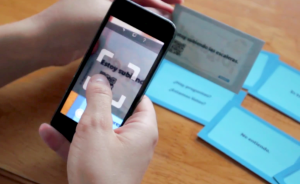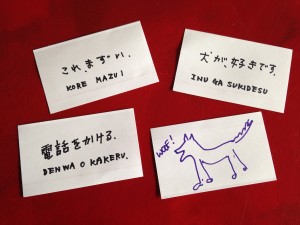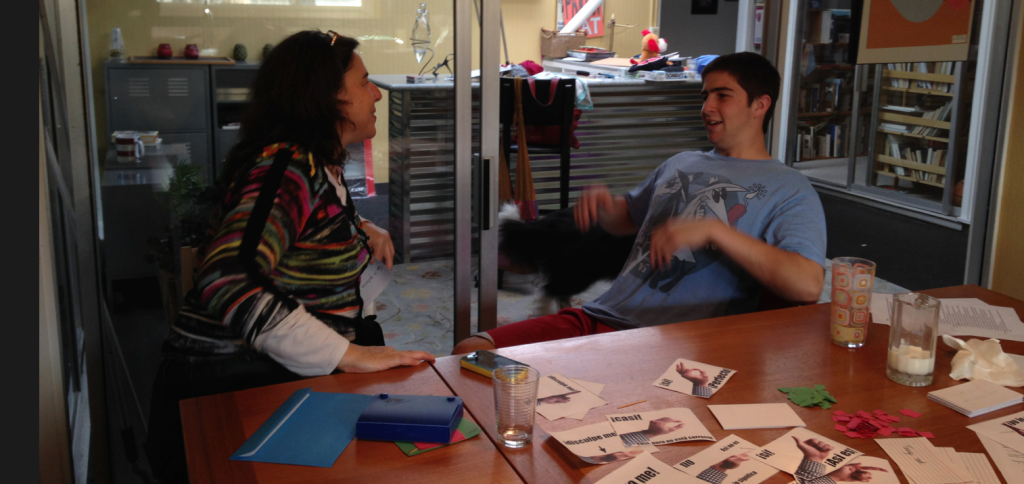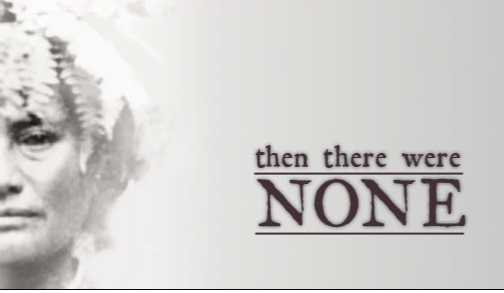 We first developed the ¡Dígame!
card game as a paper prototype for our new mobile app. Translating the game play from a
mobile, social video-based game to real life worked surprisingly well. When the idea
arose to integrate video via QR codes on the game cards, I worried that the scanning
delay and mix of phone and card game would interrupt the game play and cause the game to
be less fun. One of the biggest challenges in software design is that people say that
want something, but they can’t realize all of the implications, so you can give
someone what they ask for and have that end up as something that doesn’t improve the
experience and can be distracting. Due to this uncertainty, we launched our card game
crowdfunding campaign without the QR codes and agreed to play test them before making
the final decision on whether to include them.
We first developed the ¡Dígame!
card game as a paper prototype for our new mobile app. Translating the game play from a
mobile, social video-based game to real life worked surprisingly well. When the idea
arose to integrate video via QR codes on the game cards, I worried that the scanning
delay and mix of phone and card game would interrupt the game play and cause the game to
be less fun. One of the biggest challenges in software design is that people say that
want something, but they can’t realize all of the implications, so you can give
someone what they ask for and have that end up as something that doesn’t improve the
experience and can be distracting. Due to this uncertainty, we launched our card game
crowdfunding campaign without the QR codes and agreed to play test them before making
the final decision on whether to include them.
Last week, Glen organized a group of people who had little or no Spanish language ability. They played ¡Dígame! and had a lot of fun. With a QR Code on each card, linked to a video of a native speaker saying the phrase expressively, sometimes with gestural hints, plus having the translation into English , the “fear factor” of being immersed in this new language was greatly reduced. Each person was challenged to teach a phrase, acting it out like Charades. Even if that person had to learn from the English translation in the video, the rest of the group learned through the immersive quality of the game, decoding meaning by watching and using their own gestures while only hearing and saying the phrase in Spanish.
The feature of QR codes linked to expressive videos on the phrase cards has been a big
success so far and adds a fun dimension to the game. This week we’ll be recording our
latest revisions of the game phrases and creating links and QR codes for each phrase.
Today is the last day to pre-order the game on Indiegogo:
http://igg.me/at/digame/x/550786





 Each
also has a free version that you can start with and provides a substantial amount of
learning before you need to buy the full version for further lessons. They are quite
different and both are complimentary to each other, to the language classes and to
Mightyverse. I have found that I learn best when I can learn the same concept in many
different ways and I have found that to be true of language more than most things.
Each
also has a free version that you can start with and provides a substantial amount of
learning before you need to buy the full version for further lessons. They are quite
different and both are complimentary to each other, to the language classes and to
Mightyverse. I have found that I learn best when I can learn the same concept in many
different ways and I have found that to be true of language more than most things. Human Japanese is a
lovely application that interleaves cultural lessons with language lessons, starting
with the hiragana characters. The attention to detail is very lovely and the pacing of
the application is comfortable. The notes, gestural drawings and animated strokes really
help me understand how to write the characters where my old-fashioned paper workbook
didn’t give me enough of a clue. I highly recommend this exploration of Japanese
culture and language for the new Japanese language learner.
Human Japanese is a
lovely application that interleaves cultural lessons with language lessons, starting
with the hiragana characters. The attention to detail is very lovely and the pacing of
the application is comfortable. The notes, gestural drawings and animated strokes really
help me understand how to write the characters where my old-fashioned paper workbook
didn’t give me enough of a clue. I highly recommend this exploration of Japanese
culture and language for the new Japanese language learner.


